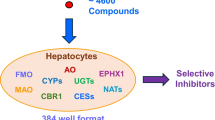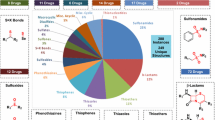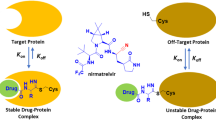Abstract
The organic cation transporter 2 (OCT2) provides an important pathway for the uptake of cationic compounds in the kidney, which is the essential step in their elimination from the organism. Although many drugs have been identified which interact with human OCT2, structural elements required for an interaction with OCT2 are not well defined. To address this issue, HEK293 cells stably expressing human OCT2 were generated. IC50 values of commonly used drugs for inhibition of [3H]MPP+ uptake were determined and correlated with physicochemical descriptors. We found only a significant correlation between the topological polar surface area (TPSA) and IC50 values (r = 0.71, p < 0.0001). Structural alignment of most potent inhibitor drugs of OCT2-mediated MPP+ uptake was used to construct a two-point pharmacophore consisting of an ion-pair interaction site and a hydrophobic aromatic site separated by 5.0 Å. Taken together, our data identify structural determinants for inhibitor interactions with OCT2.






Similar content being viewed by others
References
Affrime M, Gupta S, Banfield C, Cohen A (2002) A pharmacokinetic profile of desloratadine in healthy adults, including elderly. Clin Pharmacokinet 41(Suppl 1):13–19
Ahlin G, Karlsson J, Pedersen JM, Gustavsson L, Larsson R, Matsson P, Norinder U, Bergstrom CA, Artursson P (2008) Structural requirements for drug inhibition of the liver specific human organic cation transport protein 1. J Med Chem 51:5932–5942
Barendt WM, Wright SH (2002) The human organic cation transporter (hOCT2) recognizes the degree of substrate ionization. J Biol Chem 277:22491–22496
Bednarczyk D, Ekins S, Wikel JH, Wright SH (2003) Influence of molecular structure on substrate binding to the human organic cation transporter, hOCT1. Mol Pharmacol 63:489–498
Cheng T, Zhao Y, Li X, Lin F, Xu Y, Zhang X, Li Y, Wang R, Lai L (2007) Computation of octanol–water partition coefficients by guiding an additive model with knowledge. J Chem Inf Model 47:2140–2148
Clark DE (1999) Rapid calculation of polar molecular surface area and its application to the prediction of transport phenomena. 2. Prediction of blood–brain barrier penetration. J Pharm Sci 88:815–821
Ertl P, Rohde B, Selzer P (2000) Fast calculation of molecular polar surface area as a sum of fragment-based contributions and its application to the prediction of drug transport properties. J Med Chem 43:3714–3717
Ferrara P, Apostolakis J, Caflisch A (2002) Evaluation of a fast implicit solvent model for molecular dynamics simulations. Proteins 46:24–33
Furlanut M, Franceschi L, Pasqual E, Bacchetti S, Poz D, Giorda G, Cagol P (2007) Tamoxifen and its main metabolites serum and tissue concentrations in breast cancer women. Ther Drug Monit 29:349–352
Hardy BG, Schentag JJ (1988) Lack of effect of cimetidine on the metabolism of quinidine: effect on renal clearance. Int J Clin Pharmacol Ther Toxicol 26:388–391
Hayer-Zillgen M, Bruss M, Bonisch H (2002) Expression and pharmacological profile of the human organic cation transporters hOCT1, hOCT2 and hOCT3. Br J Pharmacol 136:829–836
Kakehi M, Koyabu N, Nakamura T, Uchiumi T, Kuwano M, Ohtani H, Sawada Y (2002) Functional characterization of mouse cation transporter mOCT2 compared with mOCT1. Biochem Biophys Res Commun 296:644–650
Kim MK, Shim CK (2006) The transport of organic cations in the small intestine: current knowledge and emerging concepts. Arch Pharm Res 29:605–616
Kimura N, Masuda S, Tanihara Y, Ueo H, Okuda M, Katsura T, Inui K (2005a) Metformin is a superior substrate for renal organic cation transporter OCT2 rather than hepatic OCT1. Drug Metab Pharmacokinet 20:379–386
Kimura N, Okuda M, Inui K (2005b) Metformin transport by renal basolateral organic cation transporter hOCT2. Pharm Res 22:255–259
Kitamura S, Maeda K, Sugiyama Y (2008) Recent progresses in the experimental methods and evaluation strategies of transporter functions for the prediction of the pharmacokinetics in humans. Naunyn Schmiedebergs Arch Pharmacol 377:617–628
Leabman MK, Huang CC, Kawamoto M, Johns SJ, Stryke D, Ferrin TE, DeYoung J, Taylor T, Clark AG, Herskowitz I, Giacomini KM (2002) Polymorphisms in a human kidney xenobiotic transporter, OCT2, exhibit altered function. Pharmacogenetics 12:395–405
Marchetti S, Mazzanti R, Beijnen JH, Schellens JH (2007) Concise review: clinical relevance of drug–drug and herb–drug interactions mediated by the ABC transporter ABCB1 (MDR1, P-glycoprotein). Oncologist 12:927–941
Moaddel R, Patel S, Jozwiak K, Yamaguchi R, Ho PC, Wainer IW (2005) Enantioselective binding to the human organic cation transporter-1 (hOCT1) determined using an immobilized hOCT1 liquid chromatographic stationary phase. Chirality 17:501–506
Moaddel R, Ravichandran S, Bighi F, Yamaguchi R, Wainer IW (2007) Pharmacophore modelling of stereoselective binding to the human organic cation transporter (hOCT1). Br J Pharmacol 151:1305–1314
Motohashi H, Sakurai Y, Saito H, Masuda S, Urakami Y, Goto M, Fukatsu A, Ogawa O, Inui K (2002) Gene expression levels and immunolocalization of organic ion transporters in the human kidney. J Am Soc Nephrol 13:866–874
Nies AT, Herrmann E, Brom M, Keppler D (2008) Vectorial transport of the plant alkaloid berberine by double-transfected cells expressing the human organic cation transporter 1 (OCT1, SLC22A1) and the efflux pump MDR1 P-glycoprotein (ABCB1). Naunyn Schmiedebergs Arch Pharmacol 376:449–461
Okuda M, Saito H, Urakami Y, Takano M, Inui K (1996) cDNA cloning and functional expression of a novel rat kidney organic cation transporter, OCT2. Biochem Biophys Res Commun 224:500–507
Palm K, Stenberg P, Luthman K, Artursson P (1997) Polar molecular surface properties predict the intestinal absorption of drugs in humans. Pharm Res 14:568–571
Pietig G, Mehrens T, Hirsch JR, Cetinkaya I, Piechota H, Schlatter E (2001) Properties and regulation of organic cation transport in freshly isolated human proximal tubules. J Biol Chem 276:33741–33746
Regenthal R, Krueger M, Koeppel C, Preiss R (1999) Drug levels: therapeutic and toxic serum/plasma concentrations of common drugs. J Clin Monit Comput 15:529–544
Schömig E, Babin-Ebell J, Russ H (1993) 1,1′-diethyl-2,2′-cyanine (decynium22) potently inhibits the renal transport of organic cations. Naunyn Schmiedebergs Arch Pharmacol 347:379–383
Schömig E, Lazar A, Gründemann D (2006) Extraneuronal monoamine transporter and organic cation transporters 1 and 2: a review of transport efficiency. Handb Exp Pharmacol 175:151–180
Shikata E, Yamamoto R, Takane H, Shigemasa C, Ikeda T, Otsubo K, Ieiri I (2007) Human organic cation transporter (OCT1 and OCT2) gene polymorphisms and therapeutic effects of metformin. J Hum Genet 52:117–122
Sirtori CR, Franceschini G, Galli-Kienle M, Cighetti G, Galli G, Bondioli A, Conti F (1978) Disposition of metformin (N,N-dimethylbiguanide) in man. Clin Pharmacol Ther 24:683–693
Solbach TF, Paulus B, Weyand M, Eschenhagen T, Zolk O, Fromm MF (2008) ATP-binding cassette transporters in human heart failure. Naunyn Schmiedebergs Arch Pharmacol 377:231–243
Somogyi A, Stockley C, Keal J, Rolan P, Bochner F (1987) Reduction of metformin renal tubular secretion by cimetidine in man. Br J Clin Pharmacol 23:545–551
Suhre WM, Ekins S, Chang C, Swaan PW, Wright SH (2005) Molecular determinants of substrate/inhibitor binding to the human and rabbit renal organic cation transporters hOCT2 and rbOCT2. Mol Pharmacol 67:1067–1077
Tetko IV, Tanchuk VY, Kasheva TN, Villa AE (2001) Estimation of aqueous solubility of chemical compounds using E-state indices. J Chem Inf Comput Sci 41:1488–1493
Tetko IV, Gasteiger J, Todeschini R, Mauri A, Livingstone D, Ertl P, Palyulin VA, Radchenko EV, Zefirov NS, Makarenko AS, Tanchuk VY, Prokopenko VV (2005) Virtual computational chemistry laboratory—design and description. J Comput Aided Mol Des 19:453–463
Ullrich KJ (1997) Renal transporters for organic anions and organic cations. Structural requirements for substrates. J Membr Biol 158:95–107
Urakami Y, Okuda M, Masuda S, Saito H, Inui KI (1998) Functional characteristics and membrane localization of rat multispecific organic cation transporters, OCT1 and OCT2, mediating tubular secretion of cationic drugs. J Pharmacol Exp Ther 287:800–805
Willett P, Barnard JM, Downs GM (1998) Chemical similarity searching. J Chem Inf Comput Sci 38:983–996
Wilson JF (2003) Survey of reference ranges and clinical measurements for psychoactive drugs in serum. Ther Drug Monit 25:243–247
Wolber G, Langer T (2005) LigandScout: 3-D pharmacophores derived from protein-bound ligands and their use as virtual screening filters. J Chem Inf Model 45:160–169
Wright SH (2005) Role of organic cation transporters in the renal handling of therapeutic agents and xenobiotics. Toxicol Appl Pharmacol 204:309–319
Wright SH, Dantzler WH (2004) Molecular and cellular physiology of renal organic cation and anion transport. Physiol Rev 84:987–1049
Yin OQ, Tomlinson B, Chow MS (2006) Variability in renal clearance of substrates for renal transporters in Chinese subjects. J Clin Pharmacol 46:157–163
Acknowledgments
This work was supported by the Johannes und Frieda Marohn-Stiftung (JK, OZ), the Deutsche Forschungsgemeinschaft (Fr 1298/5-1), the Deutsche Krebshilfe (JK, grant 107854) and the Doktor Robert Pfleger-Stiftung (OZ). We thank Beate Endreß for providing expert technical assistance.
Author information
Authors and Affiliations
Corresponding author
Rights and permissions
About this article
Cite this article
Zolk, O., Solbach, T.F., König, J. et al. Structural determinants of inhibitor interaction with the human organic cation transporter OCT2 (SLC22A2). Naunyn-Schmied Arch Pharmacol 379, 337–348 (2009). https://doi.org/10.1007/s00210-008-0369-5
Received:
Accepted:
Published:
Issue Date:
DOI: https://doi.org/10.1007/s00210-008-0369-5




